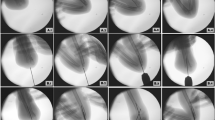Abstract
Background
Displaced supracondylar fractures are notorious for difficulty in reduction, maintenance of reduction and frequent involvement of neurovascular structures. No general agreement on the treatment is evident with controversy prevailing regarding the ideal timing of surgery, method of maintenance of reduction and configuration of the pin fixation. A crossed pin configuration, though believed by some to be mechanically more stable than the lateral pins alone, has the risk of ulnar nerve injury due to the medial pin. Lateral pins alone impart less rotational stability to the fracture although it has been attributed mainly to technical errors of pin placement. The aim of this study was to assess the efficacy of treatment of this fracture using one lateral and one trans-olecranon K-wires or lateral entry K-wires alone.
Materials and Methods
Ninety cases of displaced supracondylar humerus fractures were included in the study. The mean age of the patients was 6.7 years (range 3-12 years). The male/female ratio was 5:1 and left side was involved in 70% whereas 30% had right sided injuries. The most common mode of trauma was fall from height with elbow in extension. All the 90 consecutively admitted patients had extension type injury with 73.3% fractures being Gartland type III and 26.7% were type II. Posteromedial displacement was noted in 70% whereas 30% fractures were posterolaterally displaced. In 60 cases, lateral entry wires alone were used whereas, in 30 cases, one lateral and another transolecranon transarticular K-wire was used. K-wires were removed at 3 weeks postoperatively and followup was done at 6 weeks and 12 weeks when they were evaluated according to the criteria described by Flynn. Chi-square test was used as a statistical test of significance to compare results among different variables.
Results
Results were graded according to Flynn’s criteria. Excellent results were achieved in 12 (13.3%), good in 54 (60%), fair in 15 (16.7%) while in nine patients (10%) poor results were obtained.
Conclusions
Both lateral entry K-wires and lateral-trans-olecranon wire techniques provide stable fixation when observing the guidelines for wire placement and consistently satisfactory results can be obtained, both cosmetically and functionally with both the techniques.
Similar content being viewed by others
References
Wilkins KE. The operative management of supracondylar fractures. Orthop Clin North Am 1990;21:269–89.
Bachman D, Santora S. Orthopedic trauma. In: Fleisher GR, Ludwig S, editors. Textbook of Paediatric Emergency Medicine. Philadelphia: Lippincott Williams and Wilkins; 2006. p. 1538.
Lins RE, Simovitch RW, Waters PM. Pediatric elbow trauma. Orthop Clin North Am 1999;30:119–32.
Ippolito E, Caterini R, Scola E. Supracondylar fractures of the humerus in children. Analysis at maturity of fifty-three patients treated conservatively. J Bone Joint Surg Am) 1986;68:333–44.
Blount WP. Fractures in Children. Baltimore: Williams and Wilkins; 1955.
Pretell-Mazzini J, Rodriguez-Martin J, Auñon-Martin I, Zafra-Jimenez JA. Controversial topics in the management of displaced supracondylar humerus fractures in children. Strategies Trauma Limb Reconstr 2011;6:43–50.
Mulpuri K, Wilkins K. The treatment of displaced supracondylar humerus fractures: Evidence-based guideline. J Pediatr Orthop 2012;32 Suppl 2:S143–52.
Skaggs DL, Hale JM, Bassett J, Kaminsky C, Kay RM, Tolo VT. Operative treatment of supracondylar fractures of the humerus in children. The consequences of pin placement. J Bone Joint Surg Am 2001;83-A: 735–40.
Archibald DA, Roberts JA, Smith MG. Transarticular fixation for severely displaced supracondylar fractures in children. J Bone Joint Surg Br 1991;73:147–9.
Flynn JC, Matthews JG, Benoit RL. Blind pinning of displaced supracondylar fractures of the humerus in children. Sixteen years’ experience with long term followup. J Bone Joint Surg Am 1974;56:263–72.
Nacht JL, Ecker ML, Chung SM, Lotke PA, Das M. Supracondylar fractures of the humerus in children treated by closed reduction and percutaneous pinning. Clin Orthop Relat Res 1983;177:203–9.
Fowles JV, Kassab MT. Displaced supracondylar fractures of the elbow in children. A report on the fixation of extension and flexion fractures by two lateral percutaneous pins. J Bone Joint Surg Br 1974;56B: 490–500.
Aronson DD, Prager BI. Supracondylar fractures of the humerus in children. A modified technique for closed pinning. Clin Orthop Relat Res) 1987;219:174–84.
Pirone AM, Graham HK, Krajbich JI. Management of displaced extension-type supracondylar fractures of the humerus in children. J Bone Joint Surg Am 1988;70:641–50.
Musa M, Singh S, Wani M, Rawa S, Mir B, Halwai M, et al. Displaced supracondylar humeral fractures in children - Treatment outcomes following closed reduction and percutaneous pinning. The Internet Journal of Orthopedic Surgery 2009; 17:1.
Balakumar B, Madhuri V. A retrospective analysis of loss of reduction in operated supracondylar humerus fractures. Indian J Orthop 2012;46:690–7.
Devkota P, Khan JA, Acharya BM, Pradhan NM, Mainali LP, Singh M, et al. Outcome of supracondylar fractures of the humerus in children treated by closed reduction and percutaneous pinning. JNMA J Nepal Med Assoc 2008;47:66–70.
Lee SS, Mahar AT, Miesen D, Newton PO. Displaced pediatric supracondylar humerus fractures: Biomechanical analysis of percutaneous pinning techniques. J Pediatr Orthop 2002;22:440–3.
Wael A, Mohammed A, Boghdady GW, Ali AM. Results of treatment of displaced supracondylar humeral fractures in children by percutaneous lateral cross-wiring technique. Strategies Trauma Limb Reconstr 2008;3:1–7.
Maity A, Saha D, Roy DS. A prospective randomised, controlled clinical trial comparing medial and lateral entry pinning with lateral entry pinning for percutaneous fixation of displaced extension type supracondylar fractures of the humerus in children. J Orthop Surg Res 2012;7:6.
Foead A, Penafort R, Saw A, Sengupta S. Comparison of two methods of percutaneous pin fixation in displaced supracondylar fractures of the humerus in children. J Orthop Surg (Hong Kong) 2004;12:76–82.
Davis RT, Gorczyca JT, Pugh K. Supracondylar humerus fractures in children. Comparison of operative treatment methods. Clin Orthop Relat Res) 2000;376:49–55.
Author information
Authors and Affiliations
Corresponding author
Rights and permissions
About this article
Cite this article
Sharma, A., Walia, J.P.S., Brar, B.S. et al. Early results of displaced supracondylar fractures of humerus in children treated by closed reduction and percutaneous pinning. IJOO 49, 529–535 (2015). https://doi.org/10.4103/0019-5413.164039
Published:
Issue Date:
DOI: https://doi.org/10.4103/0019-5413.164039




